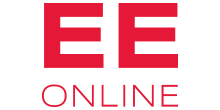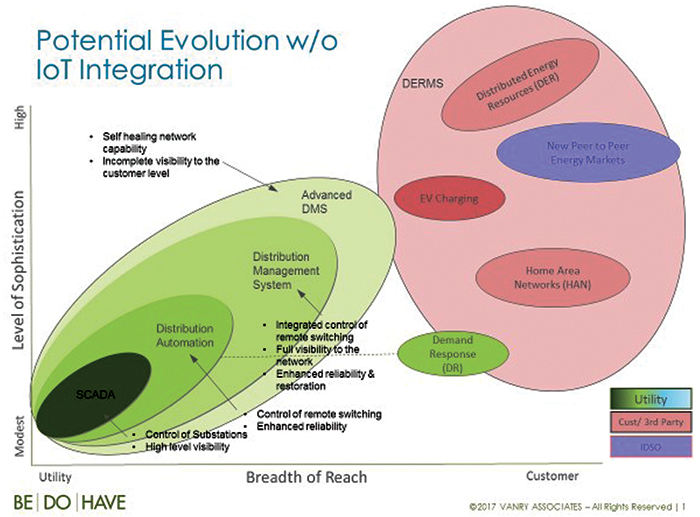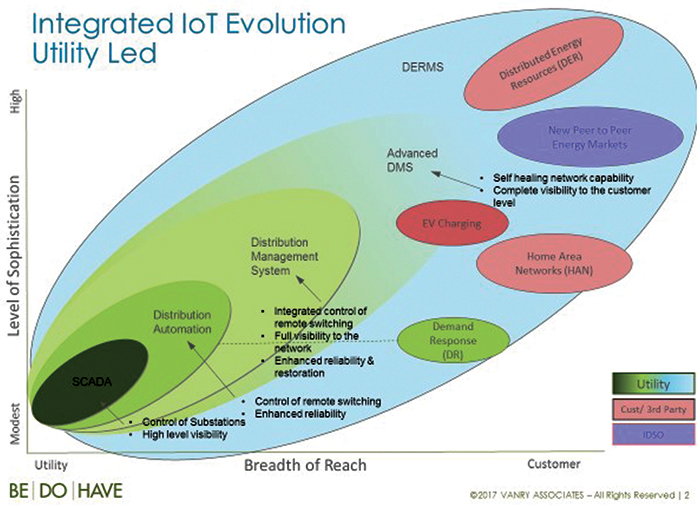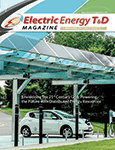There are a great many people in the market that suggest that the electric transmission and distribution network has outlived its usefulness and that as a country we should no longer be investing in the grid. While that may be a goal for many, I believe that it is a goal that is neither practical, nor realistic in the foreseeable future. There are a host of reasons why we will continue to be dependent on our network, not least of which is the role that it has played and will continue to play in increasing the percentage of renewable energy in the mix and its substantial role in helping to significantly lower the costs of renewables. In short, electricity networks have been and should continue to be a major enabler of the growth of our economy. They have seen us through our industrial growth and can provide the same value to the growth of our low carbon, renewable energy economy.
We need the network, though clearly it must change, to adapt and become part of something much larger and more intelligent. Its role has changed from being the sole source of delivered energy, to being an enabler of: new technologies, new capabilities for customers, new markets for energy, and most significantly the enabler for a greener economy, and the networks can only do this through embracing and leveraging IoT.
So, clearly IoT has huge potential for the grid and to bring benefit to customers, the economy and our society overall. It also has potential to be a significant cost and operational burden. Utilities already have a lot of data. Many are awash in data, and having far more data shows up as a cost burden and a liability (if you have the data and don’t see what it is telling you…). There are data security and cyber security concerns which I won’t cover in this article as they are worthy of deep discussions on their own.
IoT by itself is not the answer. The value lies in what we do with it. Throughout my career I learned a number of things, and one of the most important things I learned was this: Data on its own is worthless.
Leveraging processes, tools and systems to convert the data into meaningful information helps. What matters most is being able to take the data, create information and then use it to create new insights. It is the insights that enable us to make different and better decisions.
Around the globe new technologies are being deployed that allow customers to generate and store energy, to manage the energy use in their homes and businesses and to power their vehicles in new ways. In most cases these technologies are being developed to work in isolation with little consideration of the power that can be unleashed through having a seamless integrated and intelligent system.
More forward thinking utilities realize that we have a unique opportunity to redefine our role and to become the facilitator of an interconnected and intelligent grid. They see the value for customers in having their smarter homes communicating with the utility’s systems to use energy more efficiently, expand and improve their quality of life, and to lower their costs of energy. Leveraging these technologies and harnessing IoT can create the ability for customers to trade energy with neighbors, family members or in economic markets. We can leverage this network of interconnected resources to enhance reliability and reduce the cost for all customers regardless of their economic means. If we are not deliberate and thoughtful in embracing IoT, we run the risk of IoT providing value to those customers who can afford new systems and technologies at the expense of those who can’t.
In leveraging IoT, the role of utilities extends far beyond being the architect of this new era of customer empowerment. They become central to the customers and their primary relationship in everything having to do with energy and smarter living. This opens new dimensions for the relationship and, with it, new business opportunities. As the interconnectedness (information and electric) grows, the utilities can become a source of knowledge and insight offering strategies to save energy and lower costs. Utilities can be a partner that helps simplify their lives by scheduling necessary maintenance on their appliances; helping customers see when it is time to replace outdated appliances and pointing them to the best sources for purchasing new ones.
Utilities can be the enabler of energy transactions, or undertake those transactions on the customer’s behalf, thereby ensuring that they optimize the use of their distributed resources and energy usage. In such a role utilities can ensure that even the least affluent customers are provided energy, and flexibility at the lowest costs in the market.
In an interconnected future utilities are the enabler of reinventing the customer experience, while creating a cleaner more streamlined energy value chain.
So how do we prepare our network and our business for the new role as driver of the new energy economy? We see three keys:
- Embrace this new mindset
As I listen to our peers in the industry, I realize some of them still see distributed energy resources as a predatory threat. As a result, they resist these technologies and rationalize their actions. We need to recognize that these technologies bring with them the potential to meet societal goals for clean air and GHG reduction. Moreover from a purely pragmatic network view, planned and deliberate integration of these technologies enables us to improve the efficiency of the network, reducing costs to customers while enhancing reliability and security of supply. These technologies are only a threat if we fail to recognize their value in our relationship with our customers. They are a powerful tool in advancing the state of the network and empowering our customers.
- See and build the fully integrated grid (electric and data), including customers and their systems
Historically, we have viewed the connection to the customer as the end point, the last stop in the delivery system. Our support of customers’ quality of life has been limited. While we have engaged in Demand Response and Energy Efficiency programs, we have only recently begun working with customers in supporting intelligent homes (Home Area Networks – HAN), grid connected storage, and intelligent DER control.
With advances in end point technologies and IoT capabilities, we now have an opportunity to engage the customers in ways that were never available before. We expect that there will be a wide range of responses among the customers: from those that want simply to have a lower cost, more reliable supply; to those that want to participate in markets selling and buying excess energy. At minimum, we have the opportunity to offer our customers a far higher quality of life at costs below what they are paying now. We can engage with our customers in ways that we have not been able to engage with them since deregulation, and reestablish a strong and trusting relationship. Adopting a strategy of interconnectedness could allow our customers to see that we can provide their energy needs in whatever manner meets their requirements, from managing their energy consumption to optimizing their costs and providing the critical infrastructure that enables them to engage in energy markets.
- Adopt and adapt new technologies while stewarding the network
There is no doubt that integrating distributed energy resources increases the complexity of the network and brings new challenges to the safe and secure operations of the grid. These challenges are coming, regardless of our decisions to embrace technology or not. By being proactive in adopting these technologies, we have a far greater hand in ensuring that we can continue to operate and maintain the network in a safe and reliable manner. Moreover, the utility is the entity that is best positioned to see where and how these technologies can bring the greatest value to the customer base as a whole. By leading, we can ensure that we take steps to avoid the pitfalls of previous decisions, where renewable integration came as a benefit to the affluent customers and at the expense of the less affluent ones. We have the ability to look holistically at the system and optimize the overall investment, using an appropriate combination of grid and non-grid investments. We understand how to leverage the output of new resources to support the grid rather than driving unnecessary investment in it. Over time, we believe that the nature of the grid will be transformed to something that is continually optimized and continuously evolving.
It is in this third area where we must be most deliberate and thoughtful. As we look to a fully integrated customer-network grid, we recognize that the existing systems can only meet some of the immediate and future requirements. While many utilities are contemplating wholesale replacements of all of their key operational systems, IoT and advances in system technologies have created another form of solution. Over the years, most utilities have made many good system investments. Those systems however do not reach far enough to meet our needs. We do not believe that any one system is capable of meeting all of the needs, particularly when the technologies, policies and regulation continue to evolve. What we need is a system that can evolve with us, leveraging the tools that we have today, and allowing us to add new tools and new capabilities to meet changing demands. Typically, this ‘Best of Breed’ approach has been difficult to implement as integrating systems has proven problematic.
- Move to a “System of Systems” architecture for IT/OT and ET
Along with growth in IoT has come growth in capabilities in Systems of Systems. A System of Systems approach allows existing systems, sensors, programs, apps, cloud databases, to integrate seamlessly and effectively. It is in effect the ‘universal translator’ for IT, OT and External Technology (ET) systems. A SoS is the only practical way to fully leverage the potential being unleashed by IoT. The data that we need to run this future grid will exist in hundreds of different systems installed and owned by others. The notion that we can require standard interfaces is simply not realistic. We need to understand that we will have to work with what shows up, now and in the future, and it is only through a SoS approach that such universal acceptance and integration becomes possible.
Adopting a System of Systems approach could enable a fundamental shift in the potential evolution of Distributed Energy Resource Management Systems (DERMS). On our current course, DERMS appear to be emerging ad hoc in many locations. If we look holistically at what is in the best interest of all customers we might view that a more integrated DERMS (one that is amalgamated with the operation of the network) would produce the lowest cost and most reliable interconnected network.
- Build a durable strategy for communications infrastructure
In the world of IoT, communications will become even more critical. Today utilities rely on a multitude of communications media. This is likely to continue into the future as many of the sources of data will reside outside of the utilities and outside of their control. We will need to look realistically at the sources of the data and the most effective means of communications. We need to look at this pragmatically and over multi-year time horizons. The longevity of the communications paths need to align with the longevity of the data sources. Many utilities invested in end point devices that use cellular technology. Cellular has proven reliable and valuable in most cases. The concern that we now see is that cellular carriers are moving away from older 2G and 3G systems to 4G and 5G. Thus, utilities are forced to upgrade their fleets of end point devices due to the loss in communications infrastructure. While this may not require that utilities invest in their own communications infrastructure, it does suggest that communications infrastructure needs to be looked at as an integral part of the investment decision and the life cycle of all technologies, including communications, should be considered.
IoT holds great promise for customers and for utilities. Done well it can bring great benefits in lower costs, greater reliability, enhanced quality of life, and lower impacts on the environment. Done piecemeal, we run the risk of seeing significant investments with lopsided benefits. We owe it to all of our customers to embrace IoT in a pragmatic manner that brings benefits to all.
About the Author
 Stewart Ramsay is the Managing Executive of Vanry Associates, a global consulting firm specializing in strategy, leadership and executive coaching. Mr. Ramsay has more than 30 years of experience in leadership, operations, engineering and consulting roles in the global utility and technology industries.
Stewart Ramsay is the Managing Executive of Vanry Associates, a global consulting firm specializing in strategy, leadership and executive coaching. Mr. Ramsay has more than 30 years of experience in leadership, operations, engineering and consulting roles in the global utility and technology industries.









